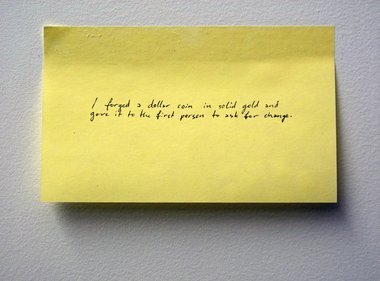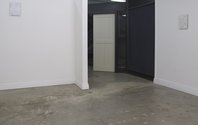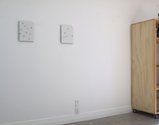John Hurrell – 10 May, 2011
One show focussing on the mental and hypothetical, the other on layered mark-making systems and their accompanying measured organisation.
This low key exhibition by John Ward Knox and Charles Ninow featured a written out conceptual art work, a sort of ‘thought experiment’ around the corner from a set of small grey grid paintings. The two projects were side by side but didn’t overlap. They were two solo shows.
But if you wanted to find an unintended common theme, you could. Ward Knox looked at generosity and fiscal exchange - pertaining to gold, and Ninow was interested in the chromatic properties of grey and aluminium metallic paint - their ‘silveriness’ and ambiguous tonal instability.
Ward Knox had a history of writing and editing (and drawing) - being an experienced text constructor his (biro drawing as writing) contribution was no surprise - and Ninow usually made site specific sculpture referencing the architectural history of a site. His writing in the catalogue seemed to speak of these paintings as made to decorate claustrophobic transient spaces, providing some symbolic visual ‘aphorism for success’. Codes that ‘reflected’ the aspirations of the temporary inhabitants.
Ward Knox presented a photo of somebody’s hand holding a dollar coin. Under this written on a sticky yellow note was: I forged a dollar coin in solid gold and gave it to the first person to ask for change.
Here solid gold replaced the aluminium bronze alloy, rapidly increasing the coin’s value - being of considerable benefit to the recipient if they happened to recognise the alteration and there was a bank nearby.
Of course it was not just about giving. It was a humorous statement involving paradox, anticipating quick-wittedness on the part of the receiver, and probably thanklessness for the donor because the action was so subtle.
Ninow’s six Concrete Relief paintings had a few small dark grey squares set within fields of a lighter grey, positioned in isolation as if made by crisscrossing strips of masking tape. The structure was not super tight in the sense that the linen stretcher proportions were not built around gridded multiples of the width of the tape. This possibility was ignored.
Also included were two other paintings quite different from these Concrete Reliefs which, needless to say, unlike for example certain works by Tom Kreisler, were not really made of concrete.
Of those, Untitled was made of a densely packed grid of squares bordered by thin masked off lines. Grey car paint seemed to have been applied to linen, gesso layered on top of that - and then to make the squares, aluminium oil paint used (vigorously over skinny tape) last of all.
The other work, Untitled (linear study #2), float mounted within a stainless steel frame, played off an underlying grid of discrete pencil dots about a third of an inch apart, against another grid of thin vertical and horizontal blue lines, half an inch long. The two competing layers, their measurements deliberately out of sync, created a peculiar - but effective - Mondrianlike tension, with the thin blue vertical and horizontal lines hovering over pencilled-in dots and dashes.
The two shows worked well together, one focussing on the mental and hypothetical, the other on layered mark-making systems and their accompanying measured organisation. Both exploring in very different ways, the nature of substitution.
John Hurrell









 Two Rooms presents a program of residencies and projects
Two Rooms presents a program of residencies and projects Advertising in this column
Advertising in this column



This Discussion has 0 comments.
Comment
Participate
Register to Participate.
Sign in
Sign in to an existing account.